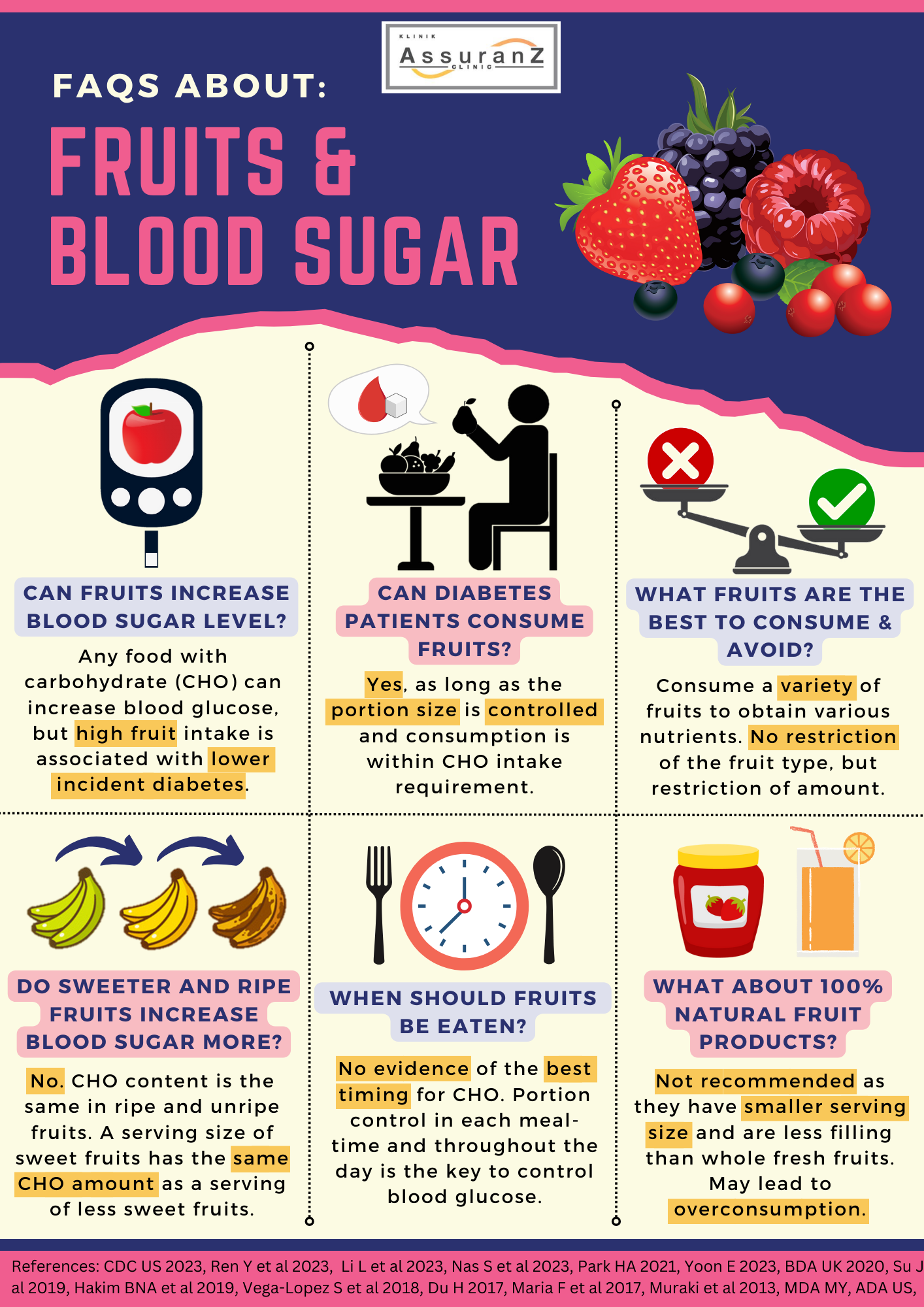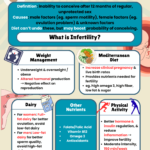Diabetes mellitus (DM) is a condition whereby one’s blood sugar is persistently high. For DM patients, it is crucial to monitor carbohydrate intake in order to achieve optimal glycemic (or blood glucose) control to prevent deleterious complications that may come with this disease such as kidney failure and diabetic foot ulcer.
糖尿病(DM)是一种血糖持续偏高的疾病。对于糖尿病患者来说,监测碳水化合物的摄入量对于实现最佳血糖控制至关重要,从而预防肾衰竭和糖尿病足溃疡等疾病可能带来的有害并发症。
Nowadays, with the increase of literacy towards health issues and the ease of obtaining information through various sources, people are more aware and are conscious about their dietary intake to prevent diabetes. Among the most popular topics associated with DM is fruits and their effect on blood glucose level. Fruits are healthy as they contain high antioxidants, vitamins, minerals, fiber and phytonutrients. Despite that, because they contain sugar, they have been said to be a cause of concern for blood glucose level. Is this true? This article will discuss more in details of this topic.
如今,随着人们对健康问题的认知提高以及通过各种渠道获取信息的便利性,人们更加意识到可通过饮食摄入来预防糖尿病。与糖尿病相关的最热门话题之一是水果及其对血糖水平的影响。水果是健康的,因为它们含有高抗氧化剂、维生素、矿物质、纤维和植物营养素。尽管如此,由于它们含有糖,而且据说它们会引起血糖水平的担忧。这是真的吗?本文将详细讨论该主题。
- Can fruits increase blood glucose level?
水果会增加血糖水平吗?
Any food that contains carbohydrates, including fruits, can increase blood glucose right after eating. This increase, whether it is quick and sharp or slow, depends on the amount of carbohydrate consumed in a seating alongside the glycemic index (GI) of the food. Most fruits are low in GI, meaning that they increase the blood glucose level slowly rather than rapid and sharp increase.
任何含有碳水化合物的食物,包括水果,进食后都会增加血糖。这种增加,无论是快速、急剧还是缓慢,都取决于消耗的碳水化合物量以及食物的血糖指数(GI)。大多数水果的GI值较低,这意味着它们会缓慢地增加血糖水平,而不是快速而急剧地增加。
For people without DM, many research shows that high intake of fresh fruit lowers risk of DM and is protective against incident DM. Meanwhile, in the newly diagnosed DM and pre-diabetes population, some research states that higher intake of fresh fruit does not worsen short term glycemic (blood sugar) control. It has also been found that there is a positive correlation between higher fruit intake and better glycemic control, and that high fruit intake can lower the risks of poor glycemic control, death and development of major vascular complications in diabetic individuals.
对于没有糖尿病的人来说,许多研究表明,大量摄入新鲜水果可以降低患糖尿病的风险,并能预防糖尿病的发生。与此同时,一些研究表明,在新诊断的糖尿病和糖尿病前期人群中,摄入更多的新鲜水果不会恶化短期血糖控制。研究还发现,较高的水果摄入量与更好的血糖控制之间存在正相关,并且高水果摄入量可以降低糖尿病患者血糖控制不良、死亡和发生主要血管并发症的风险。
This protective relationship, nevertheless, is only significant up to a certain point. While intake of around 200 to 300 grams of fruits daily reduces risks of diabetes and poor glycemic control, intake above this shows no protective effect, and can even possibly be deleterious to blood glucose control.
然而,这种保护关系仅在一定程度上才有意义。虽然每天摄入约200克至300克的水果可以降低患糖尿病和血糖控制不良的风险,但摄入量高于此水平则没有任何保护作用,甚至可能不利于血糖控制。
- Can DM patients consume fruit?
糖尿病患者可以吃水果吗?
Yes, DM patients can consume whole fresh fruits. The recommended fruit intake is two to three servings or around 200 to 300 grams of fruits per day (equivalent to around 30 to 45 grams of carbohydrates). One serving of fruit is as below:
是的,糖尿病患者可以食用整个新鲜水果。建议的水果摄入量是每天两到三份或大约200克到300克水果(相当于大约30克到45克碳水化合物)。一份水果如下:
- Very large fruits (eg. pineapple, watermelon) : 1 long slice or 1 cup
非常大型的水果(如:黄莉、西瓜):1片长片或1杯
- Large fruits (eg. mango, guava) : ½ whole
大型水果(如:芒果、番石榴):半个
- Medium fruits (eg. apple, orange) : 1 whole
中等型水果(如:苹果、橙子):1个
- Small fruits (eg. strawberry, grape) : ¾ – 1 cup
小型水果(如:草莓、葡萄):3/4 到1杯
- Dried fruits (eg. raisin, sultana, date) : 1 dessertspoon heap or ¼ cup
干果(如:葡萄干、枣子):1甜勺堆或1/4杯
Note that one should not consume two to three servings of fruit at one time, rather the fruit intake should be spread out throughout the day.
请注意,不应该一次性食用两到三份水果,而应将水果的摄入量分散在一天中。
- What fruits are the best to consume?
哪一种水果是最好的呢?
To obtain the most nutritional benefit, DM patients should take a variety of fruits as different fruits contain different minerals and vitamins composition. While currently there is not enough evidence on the GI of fruits’ effect on glycemic control, most fruits are medium to low in GI, and therefore are safe to consume.
为了获得最大的营养益处,糖尿病患者应该食用多种水果,因为不同的水果含有不同的矿物质和维生素成分。虽然目前还没有足够的证据证明水果的升糖指数对血糖控制的影响,但大多数水果的升糖指数为中低水平,因此可以安全食用。
- What fruits should be avoided?
应该避免食用哪一种水果?
There is no restriction for the types of fruit that DM patients can consume. However, because they still contain carbohydrates, they need to be included in carbohydrate counting. Thereby, the portion size should be controlled and patients should not consume a large amount of fruits at one time.
糖尿病患者没有限制可以食用的水果种类。然而,由于它们仍然含有碳水化合物,因此需要将它们纳入碳水化合物计数中。因此,患者应控制份量,不宜一次性食用大量水果。
- Are sweeter and ripe fruits more detrimental to blood glucose level?
越甜、越熟的水果对血糖水平的影响越大?
As fruits ripen, the starches – a complex carbohydrate inside the fruits which are not sweet – are degraded to become simple sugars, resulting in sweeter-tasting fruits. This process subsequently results in the increase of GI. However, it does not affect the amount of carbohydrate in the fruits; only the carbohydrate composition changes. As previously mentioned, currently there is not enough evidence on the GI of fruits’ effect on glycemic control. The amount of carbohydrate is precisely more important to be paid attention to. Thus, sweeter and ripe fruits are not inferior to unripe and less sweet fruits in terms of glycemic control.
随着水果成熟,淀粉(水果中的一种不甜的复合碳水化合物)会降解为单糖,从而使水果味道更甜。这个过程随后导致GI值增加。但并不影响水果中碳水化合物的含量;只是碳水化合物的组成发生了变化。如前所述,目前还没有足够的证据证明水果的GI值对血糖控制的影响。碳水化合物的含量恰恰是更需要关注的。因此,在血糖控制方面,较甜和成熟的水果并不逊色于未成熟和不太甜的水果。
- Should one eat fruit before or after a meal? Is it alright to eat fruits at night?
水果应该在饭前吃还是在饭后吃?晚上吃水果好吗?
Presently, there is not enough evidence on the timing of fruit intake and its effect on glycemic control. One study showed that consumption of fruit before a meal may improve satiety, but it does not have any significant effect on blood glucose level. There also have been a few studies which concluded that consumption of fruits whether as a snack or with a meal seems to have no negative effect on glycemic control. Hence, one can consume fruits at any time that they prefer, as long as it is within the recommended daily carbohydrate intake.
目前为止,关于水果摄入时间及其对血糖控制的影响还没有足够的证据。一项研究表明,饭前吃水果可能会增加饱腹感,但对血糖水平没有任何显着影响。还有一些研究得出的结论是,食用水果,无论是作为零食还是随餐食用,似乎对血糖控制都没有负面影响。因此,人们可以在自己喜欢的任何时间吃水果,只要不超过每日推荐的碳水化合物摄入量即可。
- What about other 100% natural fruit products with no added sugar?
其他100%天然不加糖的水果产品怎么样?
While products such as 100% natural fruit juice and jam with no added sugar are made from fruits, fresh fruits are recommended as one serving size (~15 g carbohydrate) is more filling, higher in fiber, and complete with vitamins, minerals and phytonutrients. Meanwhile, one serving of juice is only around 100 to 150 mL, which is around half a household glass; and one serving of fruit jam is around 1 heap teaspoon for ~15 g of carbohydrate. One can easily over-consume these products due to the small serving size and as a result, goes beyond the recommended carbohydrate and energy intake. Furthermore, the processing of the fruits can affect the fiber and nutritional contents of the end products.
虽然100%天然果汁和不添加糖的果酱等产品是由水果制成的,但建议使用新鲜水果,因为一份份量(约15克碳水化合物)更容易饱腹,纤维含量更高,并且富含维生素、矿物质和植物营养素。与此同时,一份果汁大约只有100毫升到150毫升,相当于大约家用玻璃杯的一半;一份果酱大约含1堆茶匙,约含15克碳水化合物。由于这些产品的份量较小,人们很容易过量食用这些产品,从而超出了推荐的碳水化合物和能量摄入量。此外,水果的加工会影响最终产品的纤维和营养成分。
In conclusion, whole fresh fruits can safely be consumed by DM patients, given that the amount and portion size is controlled, and that the intake stays within the recommended daily carbohydrate intake.
总之,只要控制数量和份量,并且摄入量保持在建议的每日碳水化合物摄入量内,糖尿病患者可以安全地食用整个新鲜水果。






